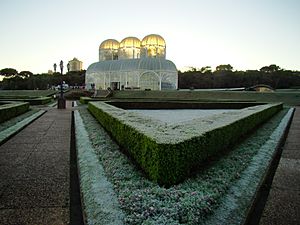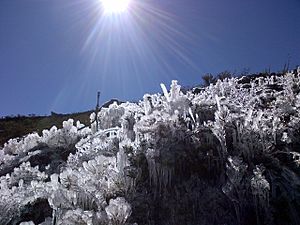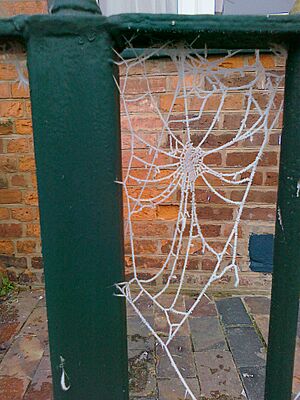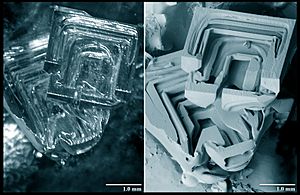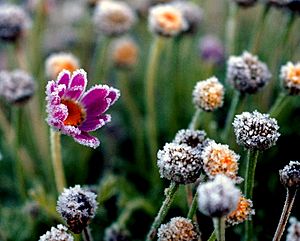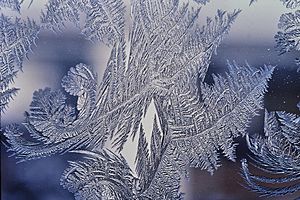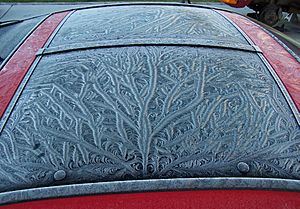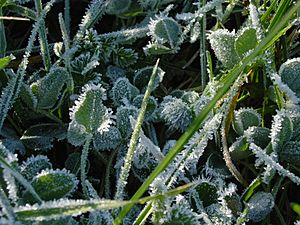Frost facts for kids
Frost is a beautiful, white layer of ice that forms on surfaces. It looks like a powdery coating. Frost happens when water vapor (water in gas form) in the air turns directly into ice. This happens on cold surfaces when the air temperature is very low, usually below freezing. Frost can sometimes harm plants and crops.
Many plants can get damaged or even die from freezing temperatures or frost. How much damage depends on the type of plant and which parts are exposed to the cold. Places like Greenhouses are used to keep plants safe from frost.
Contents
How Frost Forms
Frost forms when a solid surface gets colder than the air around it. This surface also needs to be colder than the freezing point of water. If the air is humid (has lots of water vapor), ice will start to form on the cold surface.
Think of it like this: The air has tiny bits of water vapor. When this water vapor touches a very cold surface, it doesn't turn into liquid water first. Instead, it changes directly into ice crystals. This process is called desublimation. For this to happen, the surface must be colder than the "frost point" of the air. The frost point is the temperature where water vapor turns into ice.
The size of the ice crystals you see depends on a few things. These include how cold it is, how much water vapor is in the air, and how long the crystals have been growing without being disturbed.
Frost usually forms when the surface is colder than the air around it. For example, you might see frost around cracks in cold sidewalks. This happens when warm, humid air from the ground escapes and touches the cold surface. Objects that lose heat quickly, like rusty nails, often get frost on them.
Sometimes, frost appears in one area but not in a nearby one. This can happen because of small differences in height. Lower areas often get colder on calm nights. The type of ground also affects how cold the air above it gets.
Different Kinds of Frost
Hoar Frost
Hoar frost is made of white ice crystals that form on the ground or on things like wires and leaves. It forms on cold, clear nights. This happens when heat escapes into the sky faster than it can be replaced. Objects cool down to below the freezing point of water.
Sometimes, hoar frost forms in "frost pockets." These are low areas like valleys where cold air settles. Hoar frost can even form in these pockets when the air a few feet above the ground is warmer.
The word "hoar" comes from an old English word meaning "showing signs of old age." It describes how the frost makes trees and bushes look like they have white hair.
Hoar frost has different names depending on where it grows:
- Air hoar forms on things above the ground, like tree branches or plant stems.
- Surface hoar forms directly on snow, ice, or already frozen surfaces.
- Crevasse hoar grows inside cracks in glaciers where water vapor collects.
- Depth hoar forms as large crystals deep within dry snowbanks. These crystals grow bigger by taking water from smaller nearby crystals.
When surface hoar covers snowy hills, it can create a risk for avalanches. If new, heavy snow falls on top of these frosty crystals, the fluffy crystals prevent the new snow from sticking well to the old snow below. This creates a weak layer.
Hoar frost also appears in places like freezers or large cold storage rooms. If these cold areas are not well insulated and humid air gets in, moisture will quickly freeze. This frost can build up on pipes, but it also means heat is being lost.
Advection Frost
Advection frost is also called wind frost. It forms as tiny ice spikes when a very cold wind blows over things like tree branches or poles. It often looks like a rim of ice on the edges of flowers and leaves. This type of frost usually forms against the direction of the wind. It can happen at any time, day or night.
Window Frost
Window frost is also known as fern frost or ice flowers. It forms on window panes when it's very cold outside and warmer, slightly moist inside. If the window isn't well insulated, water vapor turns into frost patterns on the glass.
The surface of the glass affects the shape of the crystals. Small scratches or dust can change how the ice starts to form. The patterns in window frost look like a fractal, which means they have repeating patterns at different sizes.
If the air inside is very humid, water might first form small liquid drops. These drops then freeze into clear ice instead of the fern-like patterns.
White Frost
White frost is a solid layer of ice that forms directly from water vapor in the air.
White frost forms when the air is very humid (over 90%) and the temperature is below -8°C (18°F). It grows against the wind direction. This is because the air coming from the windy side has more moisture. However, the wind must not be too strong, or it will damage the delicate ice crystals as they form. White frost looks like a thick coating of hoar frost, with large, interlocking crystals that are often needle-shaped.
Rime
Rime is a type of ice that forms quickly. It often happens when there's a lot of moisture in the air and it's windy. Rime is not exactly frost because it usually involves supercooled water droplets. Supercooled means the water is still liquid even though its temperature is below freezing. Ships sailing in Arctic seas can get huge amounts of rime on their ropes and equipment. Unlike the feathery look of hoar frost, rime usually looks solid and icy.
Black Frost
Black frost is not actually frost at all! It's a term used when the air is too dry for frost to form, but the temperature drops so low that plants freeze and die. The plant tissues turn black, which is why it's called "black frost." Black frost is often called a "killing frost" because it's usually much colder than white frost. White frost can actually help keep things a little warmer because of the heat released when water freezes.
How Frost Affects Plants
Many plants can be harmed or killed by freezing temperatures and frost. The amount of damage depends on the plant type, which parts of the plant are exposed, and how cold it gets. A "light frost" (around -2°C to 0°C or 28°F to 32°F) will damage fewer plants than a "hard frost" (below -2°C or 28°F).
Plants that are easily damaged by even a light frost include:
- Vines like beans, grapes, squashes, and melons.
- Plants like tomatoes, eggplants, and peppers.
Some plants can handle frost, or even benefit from it:
- Root vegetables (like beets, carrots, onions).
- Leafy greens (like lettuce, spinach, chard).
- Cruciferous vegetables (like cabbage, broccoli, kale).
Even these tough plants can be damaged if temperatures drop very low (below -4°C or 25°F). Hardy perennial plants, like Hosta, go dormant (sleep) after the first frosts. They regrow when spring arrives. The whole plant might turn brown until spring, or lose all its leaves and flowers. Evergreen plants, like pine trees, can handle frost, but most of their growth stops. A "frost crack" is a split in tree bark caused by very cold temperatures and winter sun.
Plants are not always damaged when their leaves get below freezing. If ice crystals don't form, the leaves can stay in a supercooled liquid state. They can safely reach temperatures of -4°C to -12°C (25°F to 10°F). But once frost forms, the plant cells can be damaged by the sharp ice crystals. "Hardening" is how a plant becomes able to handle cold temperatures.
Images for kids


